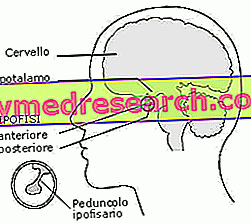Generality
The separation of the membranes is a method that allows to accelerate or induce labor, in the event that this proceeds too slowly.

The procedure is performed by the gynecologist, who creates, through the insertion of a finger inside the uterine cervix, a space between the uterine tissue and the amniocional membranes.
The effect of the separation of the membranes is double:
- On the one hand it acts on the lowering of the amniotic sac, favoring its rupture;
- On the other hand, by stimulating the cervix, the release of endogenous prostaglandins is activated and the release of oxytocin in the maternal organism is stimulated, thus increasing uterine contractions and maturation of the cervix (ie softening, smoothing and dilation).
The dissolution of membranes is a very controversial practice and not all doctors agree to use it. In general, this procedure is used when the cervix is at least slightly dilated; otherwise, this maneuver may be ineffective or inappropriate for the expectant mother.
What is the Unbundling of the Membranes
The separation of the membranes is a procedure that is carried out to induce labor and to complete the birth faster. The maneuver consists in mechanically separating the amniocional membranes from the inner surface of the cervix .
The separation of the membranes is performed by the gynecologist, inserting a finger into the cervix and rotating the finger circularly twice, to create a gap between the uterine tissue and the fetal membranes.
In the same way as other methods of inducing childbirth, the separation of the membranes is practiced when it is necessary for medical reasons, depending on the health conditions of the mother and child.
What is induction of childbirth?
Induction of childbirth is a procedure that is put in place to cause the onset of labor . The objective of this intervention strategy is the stimulation of uterine contractile activity and the induction of cervical maturation (ie softening, smoothing and dilation).
The methods of induction of childbirth are divided into pharmacological (eg, controlled release intravaginal device or prostaglandin based vaginal gel; intravenous administration of oxytocin, etc.) and not (double balloon catheter and membrane separation). These can be used alone or in sequence with each other (respecting adequate waiting times between one method and another).
The choice of the method to be used must take into consideration the indication of the induction of the birth, the level of maturation of the uterine cervix and the gestational age.
When do you run?
At the end of gestation, in most cases, labor begins naturally and spontaneously, but it may happen that this delays too much or proceeds slowly. The separation of the membranes is a valid method both to stimulate delivery and to speed it up. Usually, the maneuver is performed when, at the end of the pregnancy, labor does not start spontaneously.
The doctor may decide to perform this procedure not before the 40th week of gestation . The dissolution of the membranes serves to stimulate the start of labor or to accelerate it if it proceeds too slowly.
When is it indicated by the doctor?
In general, the gynecologist performs this technique when the woman is at the end of gestation or goes beyond the deadline (ie exceeds the 40th week of pregnancy) and considers it appropriate to induce labor.
Detachment of membranes: what is the maneuver?
The dissection of the membranes consists of mechanically separating the amniocional membranes from the inner surface of the cervix. This particular procedure is one of the options for inducing labor . This practice is useful in stimulating the start of labor.
To know
The separation of the membranes is considered a relatively simple intervention, which can positively influence the start of labor. However, it can be accompanied by disadvantages (such as a woman's discomfort during vaginal exploration) or adverse effects (bleeding, irregular contractions, etc.).
How to do it
The separation of the membranes is performed by the gynecologist (or, alternatively, by the obstetrician present in the delivery room) to induce the start of labor or to accelerate it.
The maneuver consists of inserting a finger deeply (2-3 cm) beyond the internal uterine orifice, in order to reach the lower pole of the fetal membranes. The latter is mechanically separated from the inferior uterine segment, rotating the finger circularly twice and pushing upwards as far as possible. In other words, the doctor creates a space between the uterine tissue and the fetal membranes. The effects of the detachment are not always immediate and the maneuver could be repeated several times by the gynecologist.
It should also be noted that the separation of the membranes does not always work: this means that the procedure may not be able to induce labor. In this case, it is necessary to resort to the administration of oxytocin intravenously.
How soon does the birth take place? About a quarter of women subjected to the separation of the membranes go into labor within 48 hours of the maneuver.
Preparation
- If the doctor decides that it is necessary to carry out the dissection of the membranes, it is good to know that there is an informed consent procedure. Before continuing, therefore, the expectant mother has the right to ask the gynecologist everything about what is going to happen, so as to have full awareness of the risks and benefits to which you are going. For his part, the doctor has a moral duty to inform the woman about how he intends to induce childbirth.
- The separation of the membranes is a useful maneuver, but, before proceeding, there must be some conditions . For example, if the cervix tends to expand easily, the method can work; otherwise, the separation of the membranes would be useless.
- The effectiveness of the separation of the membranes is not 100% guaranteed and a single maneuver is not always sufficient. Therefore, pregnant women may decide to opt for a different method of induction at birth, such as the administration of oxytocin.
What is the Purpose?
The purpose of the maneuver consists in inducing the birth in a natural way, as it does not involve the administration of any drug.
The separation of the amniochoral membranes from the uterine tissue stimulates the beginning of labor, as it determines the lowering of the amniotic sac, which is more fragile and ready to break. At the same time, the stress on the cervix stimulates the release of endogenous prostaglandins, useful for accelerating labor. The separation of the membranes therefore favors the softening of the cervix and uterine contractions.
When the contractions begin, then, the levels of oxytocin rise, that is, the brain produces a greater quantity, enhancing the activity of the uterus in the process of labor.
Contraindications and Complications
The birth induced with the separation of the membranes must take place only in the presence of certain situations (in this regard, there are international guidelines, specifically written to prevent this practice from becoming a sort of praxis). The guidelines of the World Health Organization (WHO) argue that the maneuver is preferable to pharmacological induction of labor.
The dissolution of the membranes is contraindicated, however, in the presence of unfavorable conditions, such as, for example:
- Pregnancy beyond the term (ie beyond the 41st week);
- Membrane breakage;
- Childbirth not yet occurred after 18 hours of labor;
- Maternal disorders (eg cholestasis, pregnancy, hypertension in pregnancy, gestational diabetes) or fetal diseases (growth problems).
Is it always effective?
Although this maneuver can contribute to the prevention of complications associated with over-term pregnancies, inducing spontaneous delivery, not all doctors believe this practice to be really useful.
The separation of the membranes is not, in fact, always sufficient to induce labor: the maneuver can be effective only when the cervix tends to expand spontaneously; otherwise, the maneuver would have no positive effect.
Is it painful?
Some women describe the maneuver as annoying, others as extremely painful. Clearly, this perception is subjective and depends on the threshold of pain that each person has. Normally, the separation of the membranes must be performed only if the cervix is "favorable" at the beginning of labor: this means that it must be soft and dilated by about 1-2 centimeters.
During late pregnancy, the cervix can be tilted towards the coccyx, making it difficult to reach. This position can make the separation of the membranes rather annoying. If the cervix is not dilated, but is soft, the doctor can massage it to stimulate it; this procedure can lead to acute pain. Furthermore, after the membranes are detached, cramps and bleeding may occur.
Risks of the separation of the membranes
The most frequent risk due to the dissolution of the membranes concerns the possibility of vaginal bleeding, similar to the menstrual one, which can develop into a hemorrhage . This eventuality can occur even at a distance of several hours from the maneuver. Obviously, the doctor must be warned, especially if the blood loss is copious. In the event of a maternal and / or fetal risk, the possibility of a cesarean section is possible.
And if it wasn't enough?
If the technique fails or turns out to be inappropriate, you can resort to other pharmacological and non-pharmacological expedients ("mechanical" methods) that fall within the scope of the induction of childbirth.
The separation of the membranes is, in fact, only one of the many solutions used to promote the delivery of the birth.
Usually, the maneuver is performed before the pharmacological induction of the birth, which involves the local application of a prostaglandin-based gel or the administration of intravenous oxytocin. If the membranes are detached, they usually wait at least 6-12 hours before applying prostaglandins.



